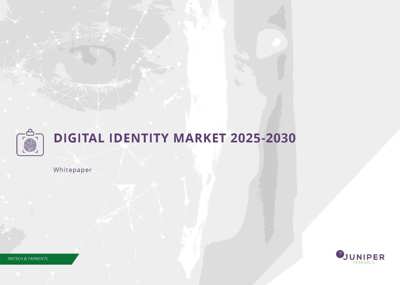Why 6G Needs to Be Built for Enterprise, Not Consumers
The telecommunications industry is at a turning point. Operators are rolling out new strategies to unlock fresh revenue streams, but one thing is clear: boosting average revenue per user (ARPU) in the consumer market will be a challenge. Most mobile subscribers simply aren’t willing to pay more unless operators significantly invest in new, value-added services.
Tech giants like Amazon, Alphabet and Apple have capitalised on their agility to launch innovative services, often built on the backbone of Tier 1 operators’ infrastructure. Meanwhile, as the chart below shows, operator revenue growth has largely stagnated over the past decade. Even with heavy investment in technologies like 4G and 5G, ARPU hasn’t kept pace.
Global Operator-billed Revenue ($m), 2013–2024

Source: Juniper Research
Operators’ attempts to generate ROI from 5G have mostly fallen short - a situation they can’t afford to repeat with 6G. While consumer revenue is set to decline, Juniper Research sees far greater opportunity in the enterprise sector. We expect this to become a core focus in discussions around 6G and what it truly needs to deliver.
Shifting from Use Cases to Real Revenue
Operators, industry groups and standard-setters working on 6G must think beyond ‘marketable’ use cases and instead prioritise the industries that will actually generate revenue. During 5G’s development, much attention was given to headline-grabbing use cases like remote healthcare, augmented reality, and autonomous vehicles. But while they sounded good, they didn’t deliver on ROI.
Take AR, for example. While 5G could support mobile AR, uptake was limited by both hardware availability and a lack of willingness from users to pay extra for connectivity. The core issue? Consumers don’t want to pay more for mobile services. Even remote surgeries - a highly publicised 5G use case - generated little return for operators, despite the technology being in place.
Lessons for 6G Development
The big lesson from 5G is this: as networks become more advanced, operators must move beyond connectivity and offer consulting and managed services to boost the value of cellular adoption. There’s a large addressable market for 6G, but only if solutions are modular and not confined to a handful of niche use cases.
Future development shouldn’t revolve around faster speeds or lower latency. Many of the use cases pitched in the 5G era were theoretically improved by better performance, but in practice, 4G was often good enough and enterprises didn’t see the need to upgrade.
Instead, 6G needs to enable enterprise autonomy; letting businesses manage their own operations over 6G, whether through private networks or simple API integrations. To tap into future growth, operators must also focus on SMEs, who often lack the internal expertise to deploy cellular services. While individual spending may be lower, the volume opportunity is significant.
What Needs to Happen Next?
As 6G networks take shape, Juniper Research believes the following are essential:
- 6G must be modular - Rather than searching for the next ‘killer app’, the telecoms industry must support a wide range of enterprise needs. 6G should be AI-native and cloud-native, allowing businesses to quickly adapt their network capabilities while reducing costs for Tier 1 operators. Our latest report on 6G development explores this in more detail.
- Service-based architecture must be a priority - This approach, already part of 5G standards, emphasises supporting services over general connectivity. For 6G, it must be front and centre, enabling a modular, API-driven framework that supports broader enterprise adoption.
- Pay-per-usage monetisation is essential - Operators need to enable flexible, ad hoc access to network services rather than tying enterprises into traditional monthly subscriptions. While APIs are already a step in this direction, wider adoption strategies are needed. Our research into network APIs provides further insights.
- ARPU is becoming outdated - With enterprise revenue set to take centre stage, the ARPU metric is losing relevance. Juniper Research recommends operators report average revenue separately for consumer and enterprise segments going forward.
6G standardisation officially began in 2024, with the ITU designating it as IMT-2030, signalling that commercial availability is expected in the early 2030s. Juniper Research forecasts initial deployments within the next five years, with wider commercial rollouts expected after 2030.
As VP of Telecoms Market Research at Juniper Research, Sam produces high-quality research on telecommunications technologies and the future of digital content. His recent reports include CPaaS, Direct-to-Cell, and Operator Revenue Strategies.
Latest research, whitepapers & press releases
-
 ReportNovember 2025Fintech & Payments
ReportNovember 2025Fintech & PaymentsDigital Wallets Market: 2025-2030
Our digital wallets research suite provides detailed analysis of this rapidly changing market; allowing digital wallet providers to gain an understanding of key payment trends and challenges, potential growth opportunities, and the competitive environment.
VIEW -
 ReportOctober 2025Fintech & Payments
ReportOctober 2025Fintech & PaymentsDigital Identity Market: 2025-2030
Juniper Research’s Digital Identity research suite provides a comprehensive and insightful analysis of this market; enabling stakeholders, including digital identity platform providers, digital identity verification providers, government agencies, banks, and many others, to understand future growth, key trends, and the competitive environment.
VIEW -
 ReportOctober 2025Telecoms & Connectivity
ReportOctober 2025Telecoms & ConnectivityTravel eSIM Market: 2025-2030
Our comprehensive Travel eSIMs research suite comprises detailed assessment of a market undergoing rapid growth. It provides insight into how travel eSIM providers can differentiate their services to maximise success in the market over the next two years.
VIEW -
 ReportOctober 2025IoT & Emerging Technology
ReportOctober 2025IoT & Emerging TechnologyDirect to Satellite Market: 2025-2030
Juniper Research’s Direct to Satellite research suite provides satellite providers, investors, and partners, such as Mobile Network Operators, with an extensive analysis and insights into the direct to satellite market.
VIEW -
 ReportSeptember 2025Fintech & Payments
ReportSeptember 2025Fintech & PaymentsInstant Payments Market: 2025-2030
Juniper Research’s Instant Payments research suite provides a wide-ranging and strategic analysis of this market; enabling stakeholders - from banks, infrastructure providers, regulators, and businesses - to understand future growth, key trends, and the competitive environment.
VIEW -
 ReportSeptember 2025Fintech & Payments
ReportSeptember 2025Fintech & PaymentsAnti-money Laundering Systems Market: 2025-2030
Our AML Systems research suite provides a detailed and insightful analysis of this evolving market; enabling stakeholders from financial institutions, law enforcement agencies, regulatory bodies and technology vendors to understand future growth, key trends, and the competitive environment.
VIEW
-
 WhitepaperNovember 2025Fintech & Payments
WhitepaperNovember 2025Fintech & PaymentsDigital Wallets: Empowering Financial Inclusivity
Our complimentary whitepaper, Digital Wallets: Empowering Financial Inclusivity, examines the state of the digital wallets market; considering the impact of digital wallets on different geographies, how they are shaping the modern payments landscape through lower transaction fees and promoting financial inclusivity for underbanked populations, and how they are competing with established payment methods.
VIEW -
 WhitepaperNovember 2025Telecoms & Connectivity
WhitepaperNovember 2025Telecoms & ConnectivityTop 10 Telecoms & Connectivity Trends 2026
The next phase of telecoms isn’t coming — it’s already here. From AI agents to new network models, our guide shows what’s changing right now and how it’s transforming the business of connectivity. Download your copy today.
VIEW -
 WhitepaperOctober 2025Fintech & Payments
WhitepaperOctober 2025Fintech & PaymentsHow Digital Identity is Going Mainstream
Our complimentary whitepaper, How Digital Identity is Going Mainstream, assesses the trends that are moving digital identity to be increasingly popular, and challenges to digital identity growth.
VIEW -
 WhitepaperOctober 2025IoT & Emerging Technology
WhitepaperOctober 2025IoT & Emerging TechnologyBeam Me Up: The Direct to Satellite Revolution
Our complimentary whitepaper, Beam Me Up: The Direct to Satellite Revolution, evaluates the future key services that satellite providers must offer in the direct to satellite market.
VIEW -
 WhitepaperOctober 2025Telecoms & Connectivity
WhitepaperOctober 2025Telecoms & ConnectivityWhy Operators Are Launching Travel eSIMs in 2026
Our complimentary whitepaper, Why Operators Are Launching Travel eSIMs in 2026, examines the outlook of the travel eSIMs market over the next five years.
VIEW -
 WhitepaperSeptember 2025Fintech & Payments
WhitepaperSeptember 2025Fintech & PaymentsFrom Detection to Prevention: The Next Era of Anti-money Laundering
Our complimentary whitepaper, From Detection to Prevention: The Next Era of Anti-money Laundering, examines the state of the AML systems market; considering the impact that a changing regulatory environment and a growing number of use cases is having on the market. Additionally, it includes a forecast summary of the total value of the AML systems market in 2030.
VIEW
-
Fintech & Payments
Digital Wallet Users to Surpass Three Quarters of Global Population by 2030
November 2025 -
Telecoms & Connectivity
Juniper Research Reveals 2026’s Defining Telecoms Trends
November 2025 -
Telecoms & Connectivity
Consumer Losses to Mobile Messaging Fraud to Fall 10% Globally in 2026
November 2025 -
Fintech & Payments
eCommerce Market to Reach 440 Billion Transactions by 2030 Globally, With Emerging Markets and Agentic Commerce Set to Accelerate Growth
November 2025 -
Telecoms & Connectivity
OTT Business Messaging Traffic to Grow 45% Globally Over Next Two Years
October 2025 -
Fintech & Payments
Fraud Detection & Prevention Spending by Financial Institutions Reaches $21 Billion Annually
October 2025
























